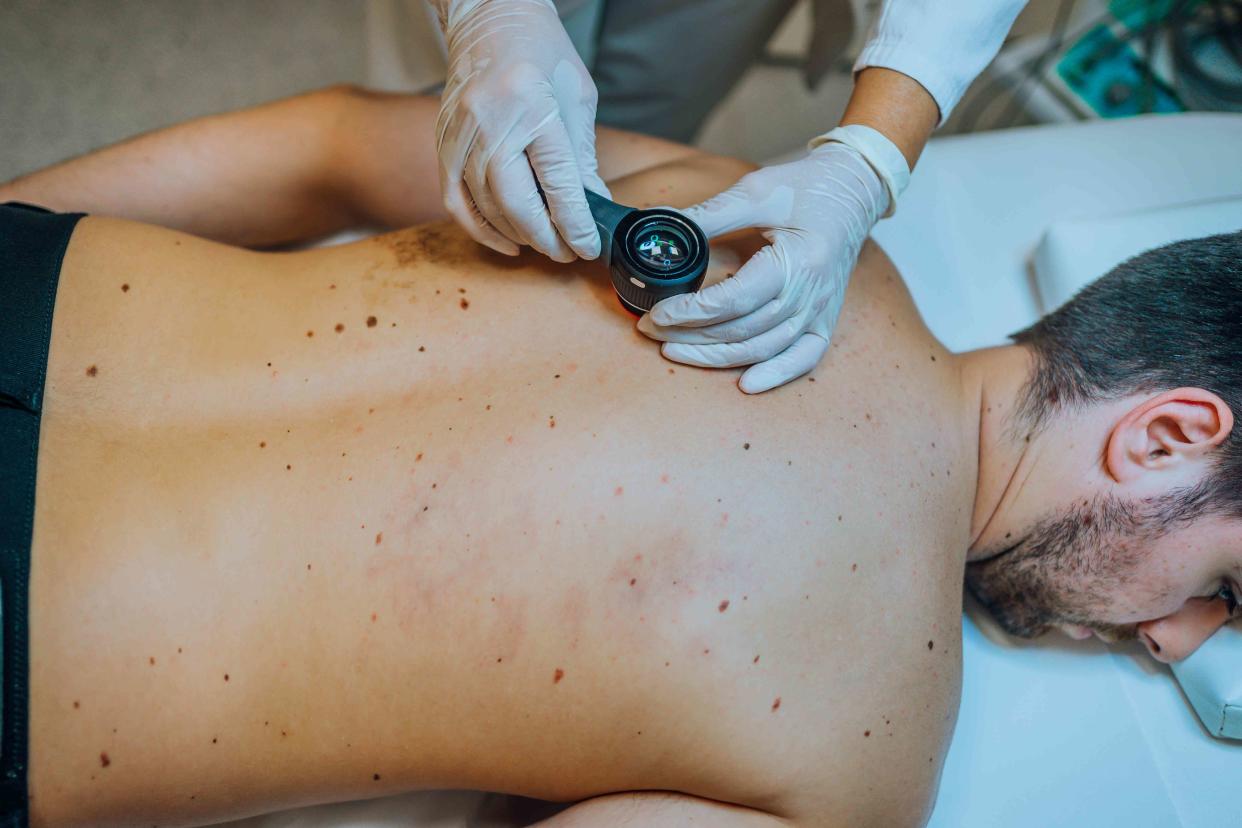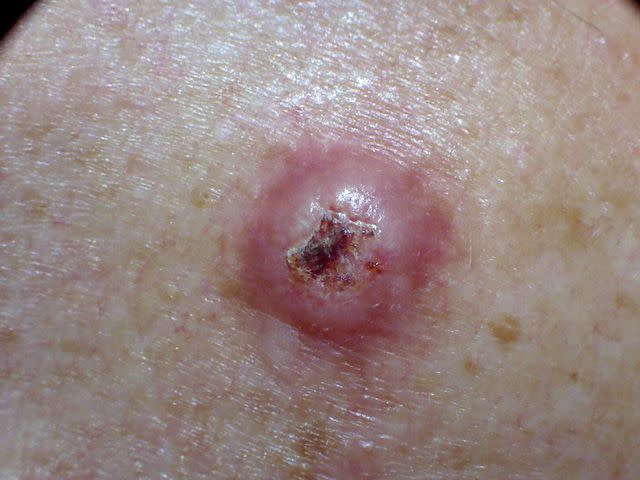What Is Squamous Cell Carcinoma?

LordHenriVoton / Getty Images
Medically reviewed by Archana Sharma, DO, FAAP
Squamous cell carcinoma, also known as squamous cell skin cancer, is a type of skin cancer. It is the second most common type of skin cancer in the United States. Squamous cell carcinoma begins in the squamous cells in the skin, located in the top layer of skin called the epidermis. The most common cause of squamous cell carcinoma is cell damage caused by exposure to ultraviolet (UV) rays from the sun or a tanning bed.
Squamous cell carcinoma often appears as an open sore that does not heal. It may also look like a red patch, wart, or area of thickened skin. Squamous cell carcinoma usually forms on areas of the skin that receive the most direct sunlight, such as the face, ears, neck, scalp, and hands. Treatment options may include surgery, radiation, or topical treatments.
Squamous cell carcinoma is usually diagnosed and treated by a dermatologist, a medical doctor who specializes in skin disorders. Fortunately, when caught early, most cases of squamous cell carcinoma are curable.
Types of Skin Cancer
Squamous cell carcinoma is considered a keratinocyte carcinoma because it starts in a keratinocyte skin cell. Keratinocyte cells are responsible for producing a type of protein called keratin. This protein helps to build the skin, hair, and nails.
The other type of keratinocyte carcinoma, basal cell carcinoma, is the most common skin cancer in the United States. A less common but more serious type of skin cancer is melanoma. Melanoma starts in the melanocytes, the cells that give skin its color.
Squamous Cell Carcinoma Symptoms
Squamous cell carcinoma is considered a slow-growing cancer. This means that when caught early, most cases are curable. The best way to catch squamous cell carcinoma early is to recognize the warning signs.
Squamous cell carcinoma usually develops on areas of the skin that see the most sunlight. It is most commonly diagnosed on the face, ears, lips, scalp, shoulders, neck, hands, and forearms.
Possible signs of squamous cell carcinoma include:
Red, scaly patches: Squamous cell carcinoma often appears as a thick, rough patch of skin. Over time it becomes red and scaly. These areas are usually painless but may feel itchy.
Open sore: A cancerous lesion may also appear as an open sore that does not heal. It may bleed and ooze, then crust over.
Elevated growth: As the lesion becomes more advanced, it starts to look like it is raised off of the skin. The edges may be raised while the center is sunken.
Wart-like nodule: Once a lesion develops raised edges, it can start to look like a wart. Advanced cases may look like a wart with a small horn-shaped growth coming out of it.
Numbness: Most cases of squamous cell carcinoma are not painful but your lesion may feel numb or like “pins and needles.” Itching is also possible.
Coloring Can Vary
The color of squamous cell carcinoma lesions can vary by your skin color. They may appear brown, black, yellow, red, or pink. They may also be the same color as your skin.

DermNet NZ
What Causes Squamous Cell Carcinoma?
Squamous cell carcinoma occurs when the DNA in the squamous cells becomes damaged. DNA is the material in our cells that stores our genetic information. When the DNA is damaged, cells can start to grow at an out-of-control rate, leading to cancer.
The most common cause of DNA damage in the skin cells is exposure to ultraviolet (UV) rays. We are exposed to UV rays each time we step outside into the sun, as well as any time we spend in tanning beds.
Risk Factors
The more time you spend in the sun, the higher your risk for squamous cell carcinoma. It’s estimated that about 90% of non-melanoma skin cancers are caused by sun exposure.
Other risk factors for squamous cell carcinoma include:
A history of skin cancer
History of tanning bed use
Age over 50
Being assigned male at birth
Fair skin
Light-colored hair or eyes
Chronic skin infections
Diagnosis
Diagnosing squamous cell carcinoma usually involves a combination of exams and tests. If your healthcare provider suspects skin cancer, they will start by closely examining your skin, noting any areas of discoloration.
In addition to taking your medical history, your healthcare provider may perform the following diagnostic tests:
Skin biopsy: This involves taking a sample of affected skin to determine if the lesion is cancerous.
Lymph node biopsy: This involves taking a sample of your lymph nodes to determine if cancer has spread there.
Computed tomography (CT) scan: This is an imaging technique that can help determine if cancer has spread to other areas of the body.
Related: Is It a Mole or Skin Cancer?
Stages of Squamous Cell Carcinoma
Once your healthcare provider diagnoses squamous cell carcinoma, the next step is to determine the stage of the cancer. Most cases of squamous cell carcinoma are diagnosed in the first stage before cancer cells have spread to other areas of the body.
The American Cancer Society recommends determining the stage of squamous cell carcinoma using the TNM system. This system is based on three factors:
Tumor: The size of the tumor and whether it has grown deeper into the skin
Node: If cancer cells have spread to the lymph nodes
Metastasis: Determines if cancer has spread (metastasized) to other areas of the body
Treatments for Squamous Cell Carcinoma
Squamous cell carcinoma is treatable, and the goal for most cases is to cure it. When left untreated, this type of skin cancer can metastasize to other areas of the body, making it harder to treat.
The most common treatment option for squamous cell carcinoma is to remove it. Surgical options include:
Excision: The surgeon removes the tumor and surrounding healthy skin with a scalpel.
Curettage and electrodesiccation: The dermatologist or surgeon uses a tool to scrape away cancer cells, then cauterizes the skin to stop bleeding. This surgery is used for small lesions.
MOHS surgery: The surgeon removes thin layers of skin and examines them under a microscope until no cancer cells are visible.
While rare, it is possible for squamous cell carcinoma to metastasize to other areas of the body. When this happens, your healthcare team will recommend additional treatment options including chemotherapy, radiation therapy, and immunotherapy.
Prevention
The best way to prevent squamous cell carcinoma is to protect your skin from harmful UV rays. To avoid UV rays, take the following precautions:
Never use a tanning bed
Wear skin-protective clothing like a hat, sunglasses, and a long-sleeved shirt
Apply sunscreen before going outdoors
Take frequent breaks when spending time in the sun
To catch skin cancer as early as possible, see your dermatologist every year for an annual skin check. See them sooner if you notice any skin changes that do not improve with time.
Related Conditions
Once you are diagnosed with squamous cell carcinoma, you are at a higher risk of developing other types of skin cancer. These include basal cell carcinoma and melanoma. If left untreated, the cancerous cells can spread to other areas of the body, such as the lymph nodes.
Living With Squamous Cell Carcinoma
Most cases of squamous cell carcinoma are diagnosed and treated before cancer has spread. However, surgical treatment may lead to complications such as scarring or disfigurement, and these changes can be bothersome. Talk with your surgeon if you feel uncomfortable with your results and ask if there are any options.
Experiencing cancer is a scary experience, and cancer that causes physical changes may also affect your body image. Finding a therapist who can help you cope with the weight of a cancer diagnosis can help.
Frequently Asked Questions
What is the survival rate for squamous cell carcinoma?
The exact survival rate for squamous cell carcinoma is unknown because there is no cancer registry that tracks it. However, death from squamous cell carcinoma is rare because this type of cancer is very treatable.
Where does squamous cell cancer start?
Squamous cell carcinoma most commonly starts on areas of the skin that receive the most sunlight. These include the face, ears, neck, shoulders, hands, and forearms.
Can squamous cell carcinoma spread quickly?
Squamous cell carcinoma is not a fast-growing cancer. Because it is slow to metastasize, it is usually diagnosed in an early stage when it is easier to treat.
Do you need chemo for squamous cell carcinoma?
Requiring chemotherapy for squamous cell carcinoma is possible but rare. Most cases are treated surgically.
For more Health news, make sure to sign up for our newsletter!
Read the original article on Health.

